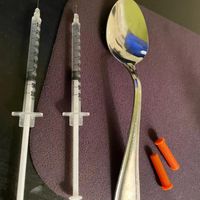The Hepatitis C virus (HCV) is one of the most prevalent blood-borne illnesses amongst incarcerated people, with incidence rates increasing across the globe. Many of the people who inject drugs (PWID) while incarcerated are forced to share drugs and drug using equipment which places them at an increased risk of contracting HCV.
According to the World Health Organization (WHO), 71 million people worldwide live with Hepatitis C. Globally, over 10 million people are currently imprisoned, with thirty percent of incarcerated men and 51% of incarcerated women reporting a substance use disorder. Often there is little to no access to needle and syringe programs. Incarcerated persons who inject drugs have eight times the prevalence of HCV compared to those who do not inject drugs.
The WHO has a plan to eliminate viral hepatitis by 2030. Incarcerated people are one of the main priority populations, but with COVID-19 diverting so many resources, how will we achieve the target goals for elimination?
In Canada, one in four federally incarcerated persons has Hepatitis C. It has been reported the prevalence of HCV in Canadian prisons is between 17-40%, which is 20-50 times higher than the general population. High transmission rates of HCV and HIV in prisons are attributed to sharing needles and cookers used for injecting drugs, putting PWID at higher risk of bloodborne pathogens and other health issues.
"In Canada, one in four federally incarcerated persons has Hepatitis C. It has been reported the prevalence of HCV in Canadian prisons is between 17-40%, which is 20-50 times higher than the general population.”
In New Brunswick, 32.5 cases of Hepatitis C per 100,000 people were reported in 2017 with injection drug use listed as the most prevalent risk factor. Substance use is overrepresented in the provincial correctional system, in comparison with the general population, with 60% of incarcerated persons reporting addiction and 48% reporting concurrent disorders. 27% percent of provincially incarcerated persons reported a positive diagnosis of HCV.
The implementation of a needle exchange program and/or supervised injection site within provincial correctional centers in New Brunswick are two possible policy responses to consider.
Since June 2018, Correctional services Canada (CSC) has been implementing federal Prison Needle Exchange Programs across Canada with the goal to reduce the risk of infectious diseases, such as HCV. The Canadian HIV/AIDS Legal Network reports that the Prison Needle Exchange Programs has inherent fundamental design flaws which ‘violate the prisoners’ confidentiality at many points without reasonable justification”.
Major policy actors that influence the implementation of Prison Needle Exchange Programs include prisoners, the healthcare team, the health authority, correctional officers, Department of Public Safety, union groups, and the public. Prisoners would benefit most from the implementation of a PNEP because it would enable them to have a safer avenue to use and decrease the risky behaviours associated with an abstinence-based model that allows for increased spread of HCV. In addition to having to use non-sterile injection equipment secondary to lack of safer supplies, incarcerated people face other high risk behaviours related to drug use that increases their chance of contracting HCV.
Correctional staff perceive Prison Needle Exchange Programs as a threat to the safety and security of the institution and the people working within it. However, in over 25 years of needle exchange policies in the prison setting worldwide, there has not been a single reported incident of assault with a needle. CSC reports that federal Prison Needle Exchange Programs contribute to workplace safety and are not associated with increased assaults on prison staff or inmates.
“In over 25 years of needle exchange policies in the prison setting worldwide, there has not been a single reported incident of assault with a needle.”
Providing access to harm reduction approaches and supplies for PWUD is well documented in the literature as effective in decreasing the transmission of HCV in the correctional settings globally. Many programs have been implemented in correctional settings without reported security threats. Individuals who are not incarcerated have access to sterile injecting equipment from local harm reduction agencies, so what’s the difference?
Correctional staff have different core values than the Department of Health and the Health Authorities. Their values are embedded within safety and security of the institution and public. Often, individualized needs of clients housed within corrections are undervalued compared to the security of the institution.
The hesitancy from correctional staff to implement a needle exchange program within the correctional setting is the most obvious barrier. Several objections including:
-
The contradiction of prison rules and the belief that Prison Needle Exchange Programs may lead to increased violence and the use of syringes as a weapon.
-
It would lead to an increased consumption of drugs and would undermine the abstinence-based message.
-
CNA reports the fear of sending the wrong message that using illicit substances is socially acceptable.
These oppositions are not validated with evidence. Prison needle exchange programs have been successfully implemented in both men’s and women’s prisons, in institutions of varying sizes, in both civilian and military systems, in institutions that house prisoners in individual cells and those that house prisoners in barracks, in institutions with different security ratings, and in different forms of custody (remand and sentenced, open and closed).
Prison Needle Exchange Program’s presents an opportunity to intervene and break the cycle of HCV transmission through evidence-based harm reduction strategies in carceral settings. It presents an opportunity to make high quality healthcare available to underserved populations. Without the implementation of a PNEP in provincial corrections, needle sharing will continue to contribute to the spread of HCV not giving a damn chance to people living with HCV who are incarcerated or society to reach the target eliminations of the WHO by 2030.




